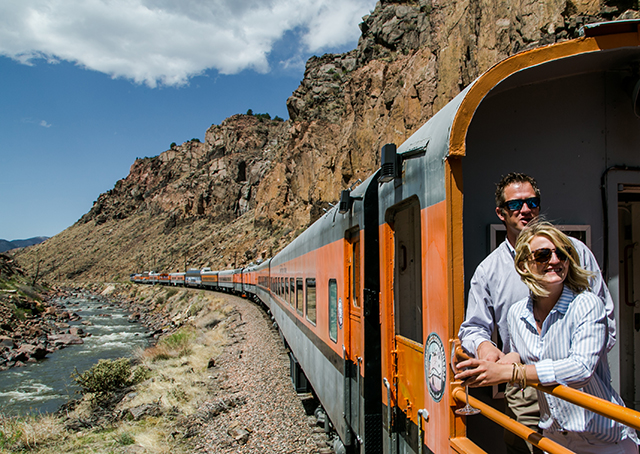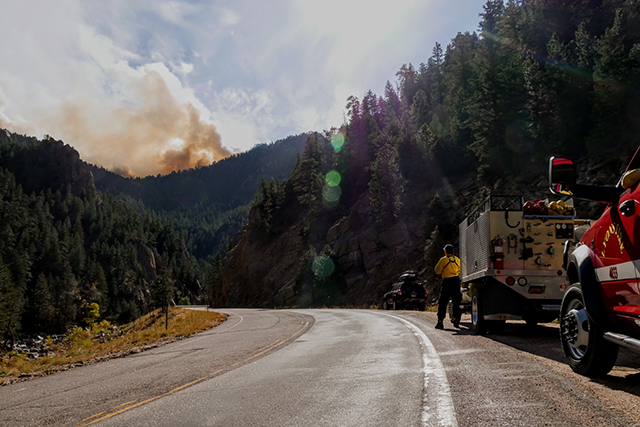Reel It In
02 Aug 2023
The ultimate fly fishing primer
By Julie Kailus
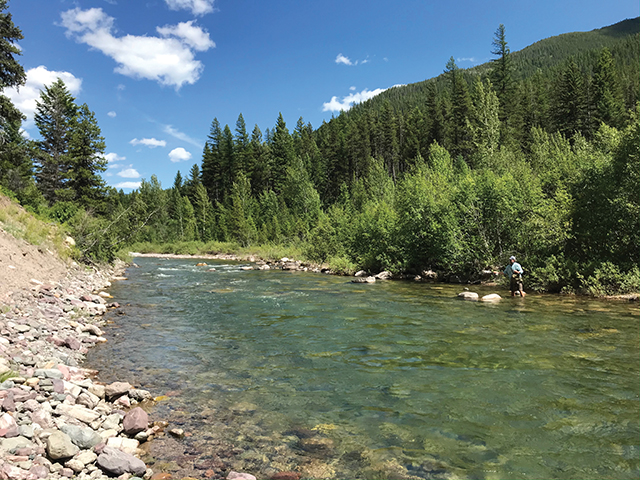
The sky stretches overhead like a vast azure canvas, brushed with strokes of wispy clouds that dance in the gentle breeze. Standing on the banks of the South Platte River, you feel the cool mountain air as you prepare to cast your line into the crystal-clear water.
You carefully select a tied fly, its intricate patterns mimicking the insects that flutter along the water’s surface. With a practiced flick of your wrist, the line gracefully unravels, landing with a splash.
As you immerse yourself in your surroundings, time gradually fades away. Suddenly, a tug on the line interrupts your reverie. Your line tightens, initiating a brief yet exhilarating battle. The trout leaps from the water, defying gravity for a fleeting moment.
At last, you cradle the trout in your hands, its iridescent hues reflecting the beauty of this wild corner of Colorado. In this moment, you transcend being an angler, becoming an integral part of something greater—a testament to the artistry of fly fishing and the profound connection that can be forged with the untamed wilderness.
Are you hooked yet? This is fly fishing 101.
Why Cast Flies?
For countless fly anglers, the phrase ‘the tug is the drug’ resonates deeply. Each tug on the line represents a link to the natural world—and an addictive one at that. The flow is near meditative—until the final reel-in breaks the cadence.
In Colorado, you can count on hooking a trout. Although, you can also find Kakonee salmon in many reservoirs; Wiper fish, which can grow to 27 pounds; and Mountain whitefish, which are native to the Yampa and White Rivers.
And then there’s the Largemouth bass, whose likeness you may have seen mounted and singing as novelty animatronic fish, Big Mouth Billy Bass. In the wild, they’re not so friendly. In fact, they’re quite the fighters and regarded as one of the most infamous fighting game fish out there. To reel in a 25-pounder is a feat of strength and skill.
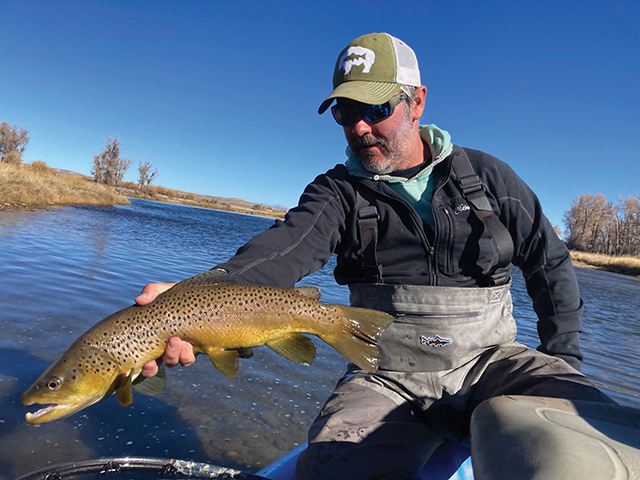
Who Angles These Days?
You’ll find anglers of all generations, races and genders out on the water. Notably, women are the fastest-growing group within the fly fishing scene, and there are more female ambassadors, guides and gear makers than ever before.
One of which includes Erica Nelson, an indigenous fishing guide and advocate for inclusivity within the fly fishing space, who’s based in the beautiful Crested Butte. She co-founded an inclusivity consulting group called REAL Consulting alongside advocacy group, Brown Folks Fishing—which aims to expand access to Black, Indigenous and People of Color (BIPOC) anglers. Together, they launched the Angling For All initiative, which calls fishing anglers, organizations and outfitters to take a pledge to combat inequality faced by BIPOC anglers in fishing communities.
That said, all those who are interested in casting a line are encouraged to strap on their waders and spend some time in the water.
Where To Get Started
Look no further than Boulder’s premier fly shops and outfitters, Rocky Mountain Anglers and Front Range Anglers. Both outfitters are taking impressive steps to bring the fly fishing experience to more people.
Rocky Mountain Anglers owner Randy Hicks says that fly fishing is a natural fit for the Colorado lifestyle, highlighting the state’s built-in access to beautiful, world-class watersheds and fisheries flowing right out the door. They provide guided fishing trips through Rocky Mountain National Park, as well as Boulder Creek, St. Vrain creeks and the Blue River, which is located near Silverthorne. For beginner anglers, there is a fly fishing course that teaches the ins and outs of knotting, rigging and casting. You can also book a one-on-one class, too.
Front Range Anglers, located on Pearl Street, also offers fly fishing trips—in and outside of Colorado. For a day trip, you’ll mosey down to Rocky Mountain National Park. Its Adventure Travel Program takes anglers to places like New Zealand, Iceland, Alaska and Belize. According to Anthony Bottagaro, Front Range Anglers guide and shop staff member, fly fishing possesses an innate romanticism, punctuated by the unique landscapes anglers flock to, including coastal enclaves and vast oceans for saltwater fly fishing for those looking to cast beyond Colorado.
And, in the heart of Rocky Mountain National Park sits Kirks Flyshop in Estes Park. Leasing over five miles of private water and with access to over 10 trout-populated lakes, Kirks Flyshop hosts a variety of fly fishing trips for all experience levels. There are backpacking trips, float trips down the Colorado River and North Platte River and even llama pack trips, in which llamas and their guides escort adventurers to secluded back-country locations. “Some trips are overnight, including float and backpack trips,” says shop owner Kirk Bien.
The shop also provides gear rentals, which include fly rods and reels, waders, wading boots, float tubes and microspikes, as well as snowshoes, poles, gaiters and sleds for those casting lines during the winter months.
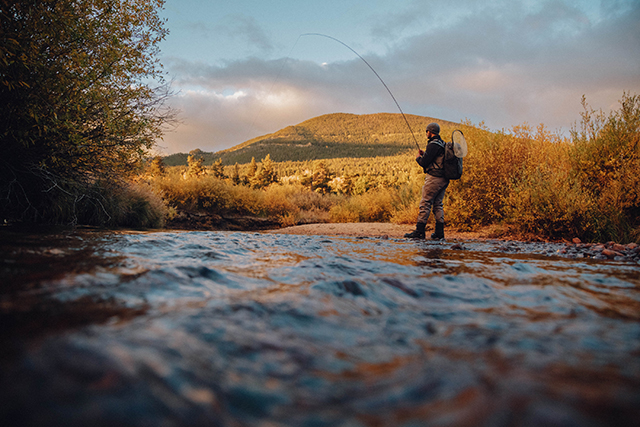
New Angler Know-How
Firstly, find an experienced guide. Front Range Anglers’ Bottagaro believes the best guides account for an angler’s existing fishing experience, including what they’ve gleaned from watching and researching online. Most fly fishing outfitters understand how to strike a balance in respecting what newbies come to the water with and teaching the most important aspects of fly fishing.
“If they’re brand new, we keep it simple,” says Bien. “I like to just do one cast. And normally it’s a water tension cast. So you’ll have the line drag down stream, let it tighten up and then you have them flop it forward. And the most important part of fly fishing, I think, is the hook set. So if their fly goes under or a fish bites, you have to set the hook (secure the fish) as soon as you see it.”
Hicks says that becoming comfortable fly fishing involves a lot of muscle memory, recommending that new anglers commit to fly angling a few times a week for a couple of hours at a time. In their free time, they can also practice the motion of casting a line or tying knots.
That said, when in the water, the key is to not cast too much—according to Bien. “The more you cast, the more tangles you get; the more your line’s in the water, the more fish you can catch.”
Also, keep your eye on the fly fishing reports—detailed updates of current fishing conditions and activity in specific locations. Fly fishing reports are typically compiled and shared by local fishing organizations, guides, fly shops or experienced anglers who regularly monitor and assess fishing conditions in a particular area. And all three aforementioned retailers provide their own online. “We get a lot of our information from our guides, as well as other fishermen in the water,” says Bien.
The Best Spots to Cast Your Line
Once you’ve gotten your feet wet and you feel comfortable at the rod, it’s time to explore the best spots to cast your line. While every angler has their own secret fishing holes, you can find beautiful—and fruitful—fly fishing locations in and outside of Boulder.
For Boulderites looking for a small skip to their local fly fishing hole, there is Boulder Creek, which has several tributaries. South Boulder Creek flows through Rollinsville, Gross Reservoir and Eldorado Canyon. North Boulder Creek begins between Navajo Peak and Arikaree Peak and meets Middle Boulder Creek, which weaves through Eldora and Nederland before reaching Barker Meadow Reservoir.
The waterway then flows down Boulder Canyon, where it eventually joints St. Vrain Creek, a popular spot for anglers. You’ll find several types of trout in the creeks, and bass, carp, shiners and sunfish may live in the ponds and reservoirs the creeks feed into.
For anglers looking for an adventure, exploring mountainous waterways may be a thrilling endeavor. For that, there is Rocky Mountain National Park. Take your gear up to Big Thompson River, The Loch, Sprague Lake, Roaring River or Lake of Glass and Sky Pond—two high-country glacier-fed lakes.
Outside of the national park, there is the South Platte River—specifically the North Fork, which begins atop Kenosha Pass. Downstream between Spinney Reservoir and Elevenmile Reservoir is also a fantastic location for those looking for larger trout. Blue River, a tributary of the Colorado River that starts at the Dillon Reservoir, also provides trophy-sized trout—and beautiful mountain views.

